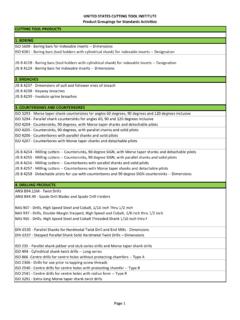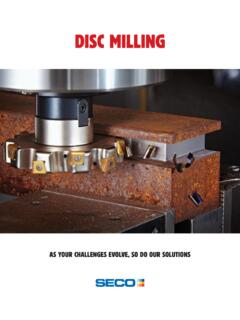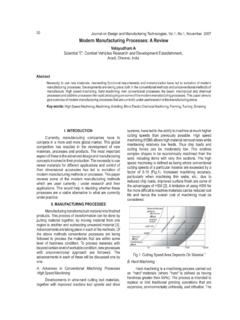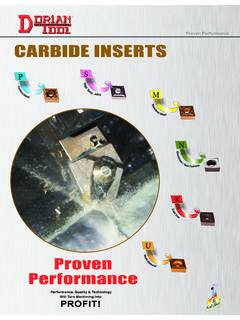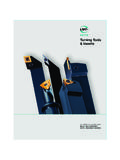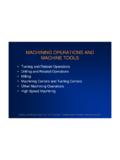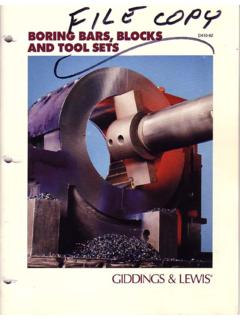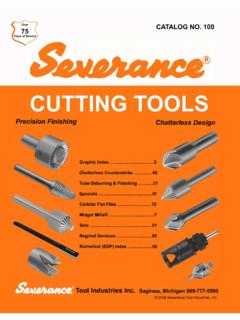Transcription of The Effect of Metallurgical Variables on the Machinability ...
1 2001-01-0409 The Effect of Metallurgical Variables on theMachinability of Compacted Graphite IronS. Dawson and I. Hollinger SinterCast Technologies AB, SwedenM. Robbins and J. DaethFord Motor Company Ltd., EnglandU. Reuter and H. SchulzPTW, University of Darmstadt, GermanyCopyright 2001 Society of Automotive Engineers, influence of graphite shape, pearlite content andchemical composition have been investigated todetermine their Effect on the Machinability of compactedgraphite iron (CGI) . In the comparison to gray iron, thereduced sulfur content of CGI prevents the beneficialformation of a protective manganese sulfide layer on thecutting insert.
2 This accounts for much of the differencein tool life during high speed continuous cutting. Beyondthis critical mechanism, the Machinability of CGI can beoptimized by providing a consistent, low nodularitymicrostructure with a minimum of tramp elements suchas titanium and chromium that form abrasive legislation and the demand for higherperformance from smaller engines have together driventhe development of diesel engine technology over thepast ten years. One of the most significant of thesedevelopments has been the advent of common rail andunit injector fuel management and delivery systems,which allow for higher cylinder pressures in directinjection diesel engines.
3 While the higher peak firingpressures provide more efficient combustion, improvedperformance, reduced emissions and quieter engineoperation, they simultaneously place increasedmechanical loads on the main bearing region of thecylinder block, potentially resulting in premature fatiguefailures. The irreversible trend toward higher peak firingpressures has prompted engine designers to seekstronger materials in order to meet their durability targetswithout increasing the size or weight of their at least 75% increase in tensile strength, 40%increase in elastic modulus and approximately doublethe fatigue strength of gray iron, CGI is ideally suited tomeet the current and future requirements of dieselengine design.
4 However, in order for CGI to gainwidespread acceptance as a cylinder block material, itsmachinability should approach that of conventional graycast general, the three available avenues for optimizing themachinability of CGI include: improving the robustnessof the insert materials; improving the machiningtechniques; and, improving the CGI itself. Although thepresent paper focuses on the extent to which variationsin the CGI composition and microstructure can influencetool life, a brief review of recent developments in CGImachining techniques is also cast iron, compacted graphite iron and ductile ironare differentiated by the shape of the graphite shown in Figure 1, gray iron is characterized byrandomly oriented graphite flakes while the graphiteparticles in ductile iron are present as individual contrast, the graphite particles in CGI appear asindividual worm-shaped or vermicular particles.
5 Theparticles are elongated and randomly oriented as in grayiron, however they are shorter and thicker, and haverounded edges. While the compacted graphite particlesappear worm-shaped when viewed in two dimensions,deep-etched scanning electron micrographs (Figure 2)show that the individual worms are connected to theirnearest neighbors in a complex coral-like graphitemorphology. Together with the rounded edges andirregular bumpy surfaces of the compacted graphiteparticles, the coral-like morphology results in strongadhesion between the graphite and the iron the smooth-surfaced graphite flakes in gray ironpromote crack initiation and growth and thus render thematerial relatively weak and brittle, the entangledcompacted graphite morphology eliminates the naturalcleavage paths thus providing strength and relative properties of the three cast irons aresummarized in Table ITypical properties of pearlitic gray, compactedand ductile cast irons, after [1]
6 In addition to the increased strength and stiffness ofcompacted graphite iron, conventional abrasion andscuffing tests show that CGI provides 30-50% betterwear resistance than gray iron. While this is positive forcylinder block and liner applications, it further illustratesthat CGI will be more difficult to machine than gray shown in Figure 3, low speed cutting (150-250 m/min)with conventional carbide inserts provides approximately50% of the tool life of gray cast iron in both milling andturning operations. Similarly, milling at high speed (400-800 m/min) with ceramic or polycrystalline cubic boronnitride (PCBN) also provides approximately 50% of thegray iron tool life.
7 Under these conditions, the differencein the tool life of gray iron and CGI is generallycommensurate with the increase in mechanicalproperties. However, the most significant difference inthe Machinability of CGI is in the high speed (>700m/min) continuous cutting operations such as turning orcylinder boring. These speeds are particularly importantas they represent cylinder boring cutting speeds inmodern high speed, high volume transfer lines. Althougha typical cylinder bore is only about 85 mm in diameterand 100 mm deep, the edge of the cutting insert remainsin constant contact with the iron for approximately 100meters as it spirals its way down the bore.
8 Under theseconditions, the ceramic and PCBN tool lives can be 10-20 times lower than those obtained with gray iron. Forthis reason, the recent development work has focusedon the critical high speed (high productivity) continuouscutting operations such as turning and cylinder Strength (MPa)250450750 Elastic Modulus (GPa)105145160 Elongation (%) Conductivity (W/mK)483728 Relative Damping (BHN 10/3000)179-202217-241217-255R-B Fatigue (MPa)110200250 Figure 1:Gray iron, compacted graphite iron and ductile iron aredifferentiated by the shape of the graphite particlesFigure 2:Deep-etched scanning electron micrographs show thethree-dimensional shape of the graphiteFigure 3.
9 Comparative tool life for different tool materials ininterrupted (milling) and continuous (turning/boring)cutting of 70-80% pearlitic CGI and gray ironIn order to become a viable material for high volumecylinder block production, the industry would ideally likethe Machinability of CGI to approach that of current grayiron cylinder blocks under transfer line , CGI cylinder blocks should conform to acycle time of less than 30 seconds with a cutting time ofapproximately 10-14 seconds per operation. The cuttinginserts should also be durable enough to satisfygeometry and roughness specifications, for an entire8-hour production parallel to the extensive work being carried out byOEMs, tooling suppliers and research institutes on insertdevelopment and improved cutting techniques, thepresent study examined the extent to which themicrostructure and metallurgy of CGI can contribute toimproved tool life.
10 In addition to the tool wear results, thepotential for the various CGI modifications to be adoptedinto series production was evaluated against thefollowing constraints:-1. The Metallurgical variations must not compromisethe desirable properties of The Metallurgical variations must not improve onemachining operation at the expense of The modifications must be sufficiently minor toensure that the product development work done thusfar remains valid. Major modifications would requirea new development cycle to validate materialproperties and engine Machinability of the various CGI alloys wasevaluated in both milling and turning operations with avariety of cutting conditions and insert , because high speed cylinder boring is themost challenging operation, the emphasis of the currentstudy was placed on continuous cutting, as simulated byturning operations on the external surface ofrepresentative test PROCEDUREThe tool wear data presented in this paper were obtainedby machining standard test pieces cast in a productionfoundry.
